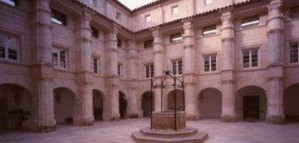
|
MENORCA
The second largest of the Balearics, Menorca still remains unspoilt despite being a popular tourist destination. For sun-worshippers, it has the best selection of un-crowded beaches in Spain, mostly on the south coast. For walkers, it has lovely countryside second to none and is rich in wild flowers including a large selection of orchids. The interior of the island has a wealth of historic and interesting features such as El Torro, the hignest point on the island, and prehistoric sites at Torre d`en Galmes and Trepuco. The entire island is a Unesco Biosphere Reserve which offers environmental protection to 75% of its territory. |
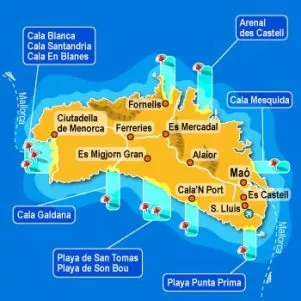 |
|
Locals speak Menorquina, a type of Catalan which even Spanish speakers find difficult to understand. Fortunately they also speak Spanish, and many in the tourist areas speak English. There are eight regions, but the capital city now is Mao or Mahon, which has one of the best deep water harbours in the world.The main part of the town is situated on top of the cliffs on the southern shoreline. Over the years, this impressive port has been fought over by many nations seeking a strategic naval base in the Mediterranean. This central location was also a focus of a range of cultures throughout history. The old capital is Ciutadella in the north west of the island which is well worthy of a full day's visit. |
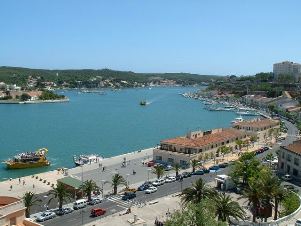 |
Los lugareños hablan Menorquina, un tipo de catalán que incluso hispanohablantes encuentran difíciles de entender. Afortunadamente también hablan a Español, y muchos en las zonas turísticas hablan a Inglés. Hay ocho regiones, pero la capital ahora es Mao o Mahón, que cuenta con uno de los mejores puertos de aguas profundas en el mundo. La parte principal de la ciudad se sitúa encima de los acantilados en la costa del sur. Durante los años, este impresionante port ha sido disputado por muchas naciones que buscan una base naval estratégica en el Mediterráneo. Esta ubicación central fue también un enfoque de una gama de culturas a lo largo de la historia. La antigua capital es Ciutadella en el noroeste de la isla que está bien digno de visita de un día completo. |
Good places to see: Visit the Museu de Minorca, housed in an old Monastery, which has exhibits from the whole history of the island going back to Roman and Byzantine periods through to more recent Muslim occupation. Find the Placa Alfons III near to the Avenida de la Constitucio for the Tourist Office in a windmill. The Placa has a good selection of cafes, bars and restaurants, for sitting and watching the world go by. A trip well worth taking, if only for the view, is to Monte Toro. The panorama from the highest part of the island is fantastic. |
|
Visite el Museu de Minorca, ubicado en un antiguo monasterio,Que tiene exposiciones de toda la historia de la isla que se remonta a épocas romana y bizantina a través de más reciente ocupación musulmana. Encuentre a Placa Alfons III cerca del Avenida de la Constitucio para la oficina de Turismo en un molino de viento. La Placa tiene una buena selección de cafés, bares y restaurantes, para sentarse y ver el mundo pasar. Un viaje bien vale la pena tomar, aunque sólo sea por la vista, es Monte Toro. El panorama de la parte más alta de la isla es fantástico. |
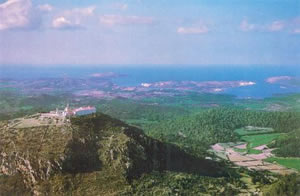 |
||
Good beaches: The southern resorts are the main tourist areas and the more popular towns include: Santo Tomas, Cala en Porter, Binibeca, Punta Prima and S`Algar. At 2.5 km long, Son Bou is the largest beach on the island. Walk just a few minutes from the parking and you will have the beach to yourself. |
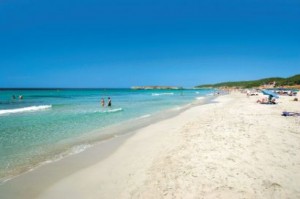 |
Los balnearios del sur son las principales zonas turísticas y las ciudades más populares incluyen: Santo Tomas, Cala en Porter, Binibeca, Punta Prima y S'Algar. A 2,5 km de largo, Son Bou es la playa más grande de la isla. A pocos minutos a pie del aparcamiento y tienes la playa a ti mismo. |
| The island is also famous for its beautiful black horses. The Menorquina breed can be traced back to the early Andalusian and Arabian cavalry horses of King Jaume II of Majorca. These were strong but capable of advanced training. During the English occupation, other thoroughbreds were introduced characterised by long legs and elegant heads. The Club Escola Menorquina puts on regular shows in summer and have been known to travel in Europe. In summer 2009 they put on a spectacular display in the UK in Manchester at the Balearic Islands Manchester Festival. The videos show the incredible agility of these wonderful horses. | 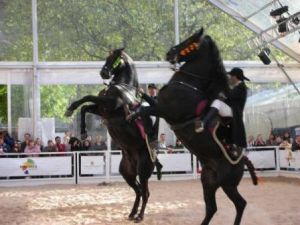 |
La isla también es famosa por sus hermosos caballos negros. La raza Menorquina se remonta a los primeros caballos de caballería andaluza y árabe del rey Jaume II de Mallorca. Éstos eran fuertes pero capaz de entrenamiento avanzado. Durante la ocupación inglesa, se introdujeron otros pura sangre caracterizada por largas piernas y cabezas elegantes. El Club Escola Menorquina pone en espectáculos en verano y se ha sabido que viajar por Europa. En verano 2009 se hizo una espectacular exhibición en el Reino Unido en Manchester en el Festival de Manchester de Islas Baleares. Los videos muestran la increíble agilidad de estos maravillosos caballos. |
Prehistoric times For a small island, there are some very important prehistoric sites dating back to the Talaiotic Period between 1000 and 2000 BC. The spectacular monuments are often in T shaped stone called Taulas believed to be old holy sanctuaries. There are also Talayots which were thought to be stone watch towers, as the word originates from the Arabic atalaya which means just that.. |
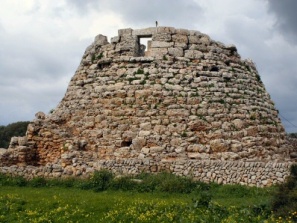 |
Para una pequeña isla, hay algunas muy importantes yacimientos prehistóricos que se remonta a la época talayótica entre 1000 y 2000 A.C. Los monumentos espectaculares a menudo están en la piedra formada de T llamada Taulas se cree que los santuarios sagrados antiguos. También hay Talayots que fueron pensados para ser Torres de vigilancia de piedra, que significa exactamente eso. |
Other great islands like Menorca |
Copyright © and TM 2007-2024 fun-learning-spanish.com |
